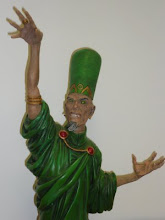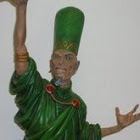
Friday, 30 October 2009
Famous Players. Rick Geary ( Writer & Art). NBM Comics (2009)

Thursday, 29 October 2009
Millennium. Tom Holland. Abacus (2009)

In one of the greatest practical jokes in history modern Europe was born because the end of the world failed to arrive when it was expected. The Christian world expected that the world would end and the Day of Judgement arrive in the at the first Millennium, one thousand years after the birth or death of Jesus Christ. The enormous social, political and religious forces this expectation released collided, combined and confronted each other to create the foundations of Western Europe as we have it today. Tom Holland has written a hugely entertaining book that shows how and why the process took place. It is a fantastic story and it is told with outstanding skill, with an enormous cast of vivid characters and a geographical range from London to Kiev, Tom Holland's talent for clarity and comprehensiveness never falters.
The prospect of the end of the world crystallised a number of forces that combined and confronted each other. On one hand there was the growth in empire building and the emergence of new ruling elites. This activity was savagely brutal and bloody. The new ruling elites wanted to be granted legitimate status and the source of this was the Christian Church. The Church was concerned with the violence of the emerging rulers while at the same time realising that they were the vanguard of the spread of Christianity, a very necessary project in the light of the upcoming divine day of judgement. The Church, as much as the secular rulers, had new elites emerge in the drive to develop an Christian empire and the confrontations between these forces is at the heart of the book.
The huge energy dedicated to getting the world in order for an event that never arrived created significant forces that had the time and energy to continue shaping the world in whatever way they saw fit. The momentum of the millennium carried them on to creating the extraordinary developments that saw Europe emerge as the political, religious and technological global leader in defiance of any prospects prior to the millennium. This exhilarating book is sweeping narrative history that shows how the present is never far from our past. Unmissable.
Saturday, 24 October 2009
Blind Eye. Stuart Macbride. HarperCollinsPublishers. (2009)

Friday, 23 October 2009
Mercy. J.M.DeMatteis (Writer), Paul Johnson (Art), Todd Klien (Letters). DC Comics (1993)

Tuesday, 20 October 2009
Bruno Chief of Police. Martin Walker. Quercus. (2009)

Monday, 19 October 2009
John Stuart Mill. Victorian Firebrand. Richard Reeves. Atlantic Books (2007)

Sunday, 18 October 2009
Team of Rivals. Doris Kearns Goodwin. Penguin Books (2009)

Saturday, 17 October 2009
Orion. Shirow Masamune (Writer & artist). Dark Horse Magna (2008)

Thursday, 15 October 2009
Fer-De-Lance (1934), The League of Frightened Men (1935). Rex Stout. Bantam Books. (2008)

Sunday, 11 October 2009
Just a Pilgrim. Garth Ennis (Writer), Carlos Ezquerra (Artist), Paul Mounts, Ken Wolak (Colours), Chris Eliopoulos (Letters). Dynamite (2008)

Saturday, 10 October 2009
The Riverman. Alex Gray. Sphere (2007)

Friday, 9 October 2009
Defoe 1666. Pat Mills (Writer), Leigh Gallagher (Art), Ellie De Ville (Letters). Rebellion (2009)

Wednesday, 7 October 2009
Appleseed. Geneon Entertainment (2004) DVD

Monday, 5 October 2009
Between The Lines. Janis Ian. CBS (1975)

The songs in this collection are drenched in this struggle between the hope for fulfillment and the sharp reality of living and the compromises that it entails. "At Seventeen" is the most explicit accounting of the divergence between reality and the dreams and the price that is extracted for having them in the first place. "Bright Lights and Promises" looks at what a life is like when the dreams you had are all you have to cling to as you move through a life you could never have imagined, a life that is based on simulating romance.

